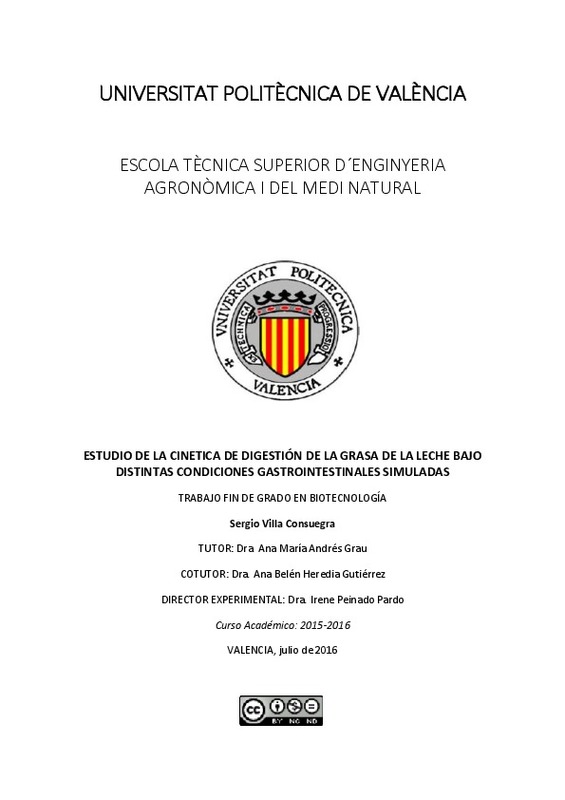|
Resumen:
|
[ES] La insuficiencia pancreática es una manifestación clínica que se caracteriza por la incapacidad
del páncreas de liberar suficiente enzima pancreática al intestino delgado, necesaria para digerir
los nutrientes ...[+]
[ES] La insuficiencia pancreática es una manifestación clínica que se caracteriza por la incapacidad
del páncreas de liberar suficiente enzima pancreática al intestino delgado, necesaria para digerir
los nutrientes intraluminares. La falta de enzimas digestivas lleva a la dificultad en la absorción
de nutrientes, que conduce a la desnutrición y la falta de crecimiento y desarrollo, debido a la
pérdida de calorías. El tratamiento habitual en personas que padecen esta enfermedad consiste
en la administración por vía oral de enzimas pancreáticas que presentan actividades proteasa,
lipasa y amilasa. No obstante, existen una serie de factores relativos al alimento (matriz, tipo de
grasa, etc.), así al entorno digestivo (pH intestinal, concentración biliar entre otros), que pueden
influir en la digestibilidad de los nutrientes. Por ello y debido a las limitaciones de este tratamiento
en términos de eficacia, se propuso el presente trabajo con la finalidad de profundizar
en el conocimiento del funcionamiento de las enzimas pancreáticas en diferentes condiciones
intestinales simuladas.
En un primer momento se procedió a evaluar la actividad lipolítica del suplemento enzimático
de pancreatina (SEP), utilizado habitualmente en el tratamiento de la insuficiencia pancreática,
en diferentes condiciones intestinales de pH (6, 7 y 8) y concentración biliar (1, 10 y 20). Los
resultados obtenidos se compararon con los resultados de lipólisis obtenidos a partir de disoluciones
de pancreatina porcina y lipasa: colipasa (10:1). Posteriormente, se utilizó un modelo de
digestión in vitro para estudiar y caracterizar la cinética de la reacción de lipólisis de la grasa de
leche. Para ello se simularon diferentes condiciones de pH (6, 7 y 8) y concentración biliar (1, 5
y 10 mM) empleando una concentración conocida de suplemento de pancreatina (8,27 UL/mL).
De esta forma, a partir de la información de las constantes cinéticas calculadas, se obtuvo la
relación enzima: sustrato que maximiza la eficiencia catalítica de la enzima.
Los resultados mostraron la influencia del efecto del pH y la concentración biliar en la actividad
de las disoluciones enzimáticas (SEP, pancreatina porcina y lipasa: colipasa). La actividad aumentó
tanto al incrementar el pH de 6 a 8, como al aumentar la concentración de bilis alcanzando
un máximo a 10 mM. Por otro lado, los resultados de cinética mostraron que el aumento
del pH y concentración biliar tiende a aumentar la velocidad de reacción (aumenta rm) así como
la afinidad de la enzima por el sustrato (disminuye km). Finalmente, las relaciones E/S que saturan
a la enzima mostraron que para aquellas condiciones duodenales favorables (pH 7-8 y 10
mM), la enzima es capaz de alcanzar valores máximos de velocidad con bajas cantidades de sustrato.
De esta forma, conociendo la relación E/S para la cual se alcanza la velocidad máxima, será
posible calcular la dosis óptima de enzima para lograr la máxima eficiencia lipólítica.
[-]
[EN] Pancreatic insufficiency is a clinical manifestation characterized by the in-ability of the pancreas
to release enough pancreatic enzyme into the small intestine, necessary to digest intraluminal
nutrients. The lack ...[+]
[EN] Pancreatic insufficiency is a clinical manifestation characterized by the in-ability of the pancreas
to release enough pancreatic enzyme into the small intestine, necessary to digest intraluminal
nutrients. The lack of digestive enzymes leads to the difficulty to absorb nutrients, which drives
to malnutrition and lack of growth and development, due to the loss of calories. The habitual
treatment of these patients involves oral administration of pancreatic enzymes with protease,
lipase and amylase activities. However, there are a number of food related factors (matrix, type
of fat, etc.) and digestive environment (intestinal pH, bile concentration, among others), which
will influence the digestibility of nutrients. Therefore, and due to the limitations of this treatment
in terms of efficacy, this study was proposed in order to deepen the understanding of the
functioning of pancreatic enzymes under different simulated intestinal conditions.
At first study was addressed to evaluate the lipolytic activity of the pancreatic enzyme supplement
(PES), commonly used in the treatment of pancreatic insufficiency, under different intestinal
conditions of pH (6, 7 and 8) and bile concentrations (1, 10 and 20 mM). The obtained
results were compared to those obtained with solutions of porcine pancreatin and lipase: colipase
(10: 1). Subsequently, an in vitro digestion model was used to study and characterize the
kinetics of the lipolysis reaction of milkfat. For this, different pH conditions (6, 7 and 8) and bile
concentrations (1, 5 and 10 mM) were simulated, using a fixed concentration pancreatic supplement
(8.27 UL / mL). Thus, from the information of the calculated kinetic constants, it was possible
to obtain the enzyme: substrate ratio that maximizes the catalytic efficiency of the enzyme.
The results illustrate the influence of the pH and bile concentration in the activity of the enzyme
solutions (SEP, porcine pancreatin and lipase: colipase). The activity increased by increasing both
the pH from 6 to 8, as well as by increasing the bile concentration, from 1 to 10 mM. Moreover,
the results showed that an increase in pH and bile concentration tends to increase the reaction
rate (increases rm) as well as the affinity of the enzyme for the substrate (decreases km). Finally,
relations E/S saturating the enzyme showed that, at favorable duodenal conditions (pH 7, 8 and
10 mM) the enzyme is able to reach a maximum speed with low amounts of substrate. Thus,
knowing the E/S at which the maximum speed is reached, it will be possible to calculate the
optimal enzyme dose to achieve the maximum lipolytic efficiency.
[-]
|







